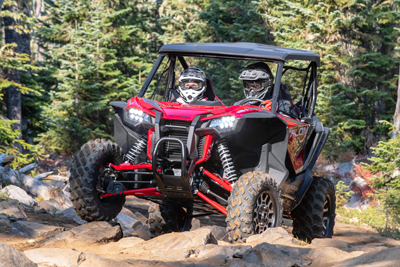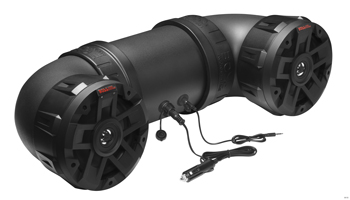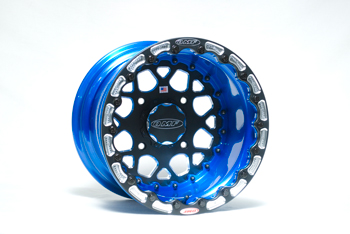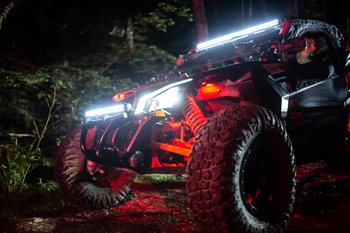SEMA News—July 2019
BUSINESS
Upward Trend in Powersports
Motorcycles Stay the Course While UTVs Reach New Heights
 The ’19 Honda Talon is the latest entry into the UTV segment. Although motorcycles still account for the bulk of powersports vehicle sales, side-by-sides are currently propelling the category’s overall growth. |
Of the many categories that comprise the aftermarket, powersports stands out with consumers for its ability to offer fun, utility and outdoor recreation. According to research by Global Market Insights, the industry is expected to trend upward from $11 billion in 2018 to $14.5 billion by 2025. Interestingly, much of the current growth is attributable not to motorcycles, the category’s traditional stalwarts, but to the rise of utility-task vehicles (UTVs), also commonly called side-by-sides.
“While motorcycles represent the most mature segment of the powersports market, sales of new two-wheelers have tumbled during the past decade,” said Greg Boeder, senior partner of Power Products Marketing (PPM), a powersports market research and analysis firm. “However, the relatively young UTV market has been on a tear during that same time.”
Boeder cited statistics from the Motorcycle Industry Council indicating that there were approximately 457,000 new motorcycles and scooters sold in the United States last year, a 2.8% drop from 2017 and a 55.3% drop from the 1,022,000 units sold in 2006. By contrast, PPM’s recent estimates show a record 458,000 UTVs sold in the United States in 2018, up 5.9% from 2017 and a 95.3% gain from 2006. Harley-Davidson currently dominates motorcycle market share, while Polaris tops UTV sales.
“While Harley continues to lead the pack with nearly 30% market share in motorcycles, it appears that brands such as Kawasaki, Honda and KTM are experiencing growing sales in an otherwise subdued market atmosphere,” Boeder said. “On-road, we’re seeing the cruiser segment experiencing declining sales; growth in sport bikes benefiting from small-displacement models from Honda, Kawasaki, KTM and Suzuki; and touring bikes are also experiencing declining sales, although with BMW, Honda, Moto Guzzi and Suzuki bucking the trend. Also, motorcycles we deem as standards are seeing increased interest from consumers, with Yamaha, Kawasaki and Triumph leading the way. Dual-sport sales are up, with most brands doing well, and the off-road market is holding its own, with much of the interest centered on motocross bikes from Yamaha, Honda and Kawasaki.”
Boeder cited several factors contributing to the growing popularity of dual-sport models among both novice and experienced consumers. First, they’re adept on both mountain trails and roads. Plus, they combine a relatively low purchase price, a standard operating platform and utility.
“While dual-sports still represent only 10% of the total two-wheeler market, it is interesting to note the increasing number of models being offered by OEMs,” Boeder added. “In fact, vehicles that can straddle the line between utility and sport seem to be popular in most segments of the powersports industry.”
That is notably true of side-by-sides. Almost 20 years ago, the vehicles were touted for industrial and commercial uses, such as construction, farming and ranching, and turf maintenance. However, the ’04 introduction of the Yamaha Rhino broadened the class’s appeal to outdoorsmen and off-roaders. Three years later, Polaris jumped in with the RZR, and the race was on. Boeder said the UTV’s instant popularity is no surprise.
“They’re easy to operate, useful in multiple terrains for work or play and—like boating—you can bring multiple people along to enjoy the ride,” he said. “While utility crossovers continue to dominate the UTV segment, recreational utilities have realized stellar growth over the past five years as consumers look to a vehicle that serves as a functional utility vehicle but can also be used for hunting as well as playtime in the woods, mud or sand.”
 Audio upgrades are notably popular with ATV/UTV owners. Weatherproof plug-and-play units such as the 450-watt Boss Audio ATVB65R Bluetooth sound system bring versatility and ease of connection to the trails. |
Broadening Appeal
Nate Martinez, performance coordinator for Team Alba Racing, a manufacturer of UTV performance parts based in San Diego, California, said that side-by-sides have also brought the thrill of the power-sports category to a broader audience.
“ATVs or dirt bikes had a lot of restrictions on where you could use them compared to what you can do with a side-by-side,” he noted. “You now see people who are going from the dunes to Moab and rock crawling to complete mud vehicles on 47-in. tires.”
“Some of those vehicles are used very hard, in different markets and in different ways,” confirmed Jason Hanson, sales manager for Boss Audio, a maker of a full line of powersports sound systems. “In a lot of areas, they’re used as hunting vehicles. In Southern California, they’re used for recreation in [places such as] Glamis or Ocotillo Wells. If you go to Texas, they’re going through mud bogs, same as in Florida. In a lot of areas, though, they’re being used as utility vehicles, and in places like Utah, you can actually drive them on the street and use them as transportation.”
In fact, Hannon believes that the motorcycle market remains stable, thanks in part to side-by-sides.
“They’re sort of tied together,” he said. “[However,] the ATV and quad markets are shrinking dramatically. That’s just because it used to be that you’d need four quads for a family of four to go out to ride, and you’d need to trailer them and have helmets and all that riding gear to go along with them. Now you can have one four-passenger side-by-side, and that takes care of your entire family. That’s why the growth of the side-by-side market is skyrocketing. It’s a lot more fun to do with a group. You can take people with you, and also there isn’t as strong of a concern for safety, particularly for younger riders.”
For now, the Polaris RZR rules the UTV roost, mainly due to the vehicle’s production volumes, according to Team Alba’s Martinez.
“Are there vehicles that compete with it? Yes, 100%,” he said. “Can-Am has come to market with an awesome vehicle that has its pluses but obviously has its minuses. Pretty much every manufacturer right now [is the same]. The number-one Polaris competitor is Can-Am, and then you’ve got Yamaha. You also have Arctic Cat/Textron, and you have Honda, which recently released its first real side-by-side. In reality, each of those vehicles has a plus and a minus that puts it ahead of or behind each other in a different area.”
PPM’s Boeder also sees regional differences again at play among competing OEM brands.
“The Mississippi River can be considered the general line of demarcation,” he said. “The western half of the United States is lightly populated and offers a vast amount of open public land on which to recreate with UTVs that sport long-travel suspension and high horsepower, such as the Polaris RZR XP Turbo, Can-Am
Maverick X3 and Yamaha YXZ 1000R. Across the river, the eastern half of the United States is more densely populated and offers much smaller wooded areas in which to recreate. Often, the wooded areas open to off-road recreation in those eastern states impose width limits on vehicles—a reason manufacturers introduced 50-in.-wide models such as the Polaris RZR 900 and Can-Am Maverick Trail.”
Incidentally, such variations extend to motorcycles as well.
“Off-road motorcycle enthusiasts in the deep woods of Tennessee certainly have their bikes set up differently than folks riding the rocky trails of Utah,” Boeder said. “As for sport bikes, you’re more likely to see a Suzuki Hayabusa with a stretched swing arm on the straight roads of Florida rather than in the hills of SoCal, where you have all of those twisties to contend with.”
As OEM participation has broadened, the UTV consumer demographic has undergone a seismic shift also.
“It used to just be the more middle-aged and older group that was using a side-by-side because of the ‘old with age comes a cage’ adage,” explained Martinez at Team Alba. “It was a safer vehicle. Nowadays, heck, they’ve started development of side-by-sides down to 170 cc, where kids are getting involved and driving right next to their parents in their own vehicles. I don’t think we can really target a particular age group at all, or even a demographic for that matter, because there are so many different riding styles and environments that these things are usable in.”
 Bigger tires and wheels are also favored UTV upgrades, making the market especially competitive. OMF Performance Products has carved out a successful niche creating one-off/custom beadlocks such as the 15x30 Billet Center Series. |
Hot on the Trails
In regard to aftermarket purchasing habits, SEMA market research indicates that about 82% of UTV owners have purchased or plan to purchase upgrades to their UTVs, with accessory decisions made early. In fact, most purchases occur within the first three months.
Enhancing functionality is among the top priorities, especially since UTVs are frequently used year-round for varied activities across diverse terrains. Moreover, UTV owners are often focused on safety over speed, durability over performance, and practicality over excitement, as evidenced by the most popular upgrades: hitch balls, tow hitch receivers and rearview mirrors.
“As one would suspect, utility-oriented modifications are also very popular with off-road enthusiasts, whether motorcyclists, UTV operators or sledders,” agreed Boeder at PPM. “Here we’re looking at auxiliary lighting, racks and other storage solutions as well as specialized tools, self-recovery items, etc. For those supplying the market, UTVs are the most promising segment.
According to Steve Shankin, industry expert and president of Seizmik, accessory spending per UTV is up 50%–60% in the past two years, and taking into account only accessorized UTVs and not
zeros [reported as sold without accessories], the average per accessorized unit has reached $3,651.”
Although a practical bunch, UTV owners don’t shy from a thrill or two.
“Powersports enthusiasts have always strived for more performance out of their vehicles of choice, so we do believe that easy bolt-on modifications such as intakes and exhausts, suspension bits and tires and even ECUs are often among the first items to be modified utilizing aftermarket products,” Boeder observed.
Martinez also attested to that.
“I’d say [it’s] in line with the old standards of exhaust, intake and all the fuel-injection tuning,” he said. “ECU tuning is also a giant thing nowadays. For the most part, every single manufacturer has left something on the table inside of the tune. Add to that the small protective parts that we’ve learned have prevented more expensive failures over time on particular vehicles. I would call them safety items that you add for your vehicle rather than yourself.”
Along the latter lines, items such as belts, clutch guards and increased cooling system capacity and protection often top the list among Team Alba’s customers, many of whom are Yamaha enthusiasts.
“I would say that the largest market as far as aftermarket performance parts is definitely the Yamaha,” he said. “It’s so accepting to modifications that we probably sell 10 times as many performance parts for those as any other vehicles right now.”
Given the dark terrain that UTVs often inhabit, it’s little surprise that aftermarket lighting companies are seeing sales to the segment steadily climb.
“Hands down, the UTV market is the largest powersports lighting consumer for us,” said Vision X Lighting Marketing Director Danny Adair. “In OE form, most of the machines have lackluster headlights and no auxiliary lights, thus creating the need for additional lighting or brighter OE-replacement options. As a solution provider, we like to think that they’re looking for the best performance; however, we’ve learned that looks and style are still one of the top priorities.
“We’ve found that the LED pods such as our 3.7-in. Mini Cannons and XPL single-row light bars are the most popular forward-lighting additions. That size allows them to be mounted on the A-pillars or front bumpers, providing a tremendous amount of light without drawing large amounts of power. UTVs typically don’t have an alternator, so power draw is a conscious decision when choosing how many lights and what lights to run. Our next popular product category is vehicle-specific items such as Polaris RZR headlight kits or bolt-in lightbar kits. The easier we can make the installation, the easier it is for the customer to hit the trail.”
Yet lighting companies such as Vision X haven’t forgotten that motorcycles still comprise the core of the powersports market despite present UTV trends.
“The dual-sport/adventure-bike market is still growing,” Adair explained. “We’ve seen an uptick in demand for complete auxiliary lighting systems, which we manufacture for some partners. The 3–4-in. pods with the ability to change colors and beam patterns is proving to be the right solution for this group—bright, yet lightweight
and versatile.”
Meanwhile, the rising UTV tide has grabbed the attention of larger manufacturers in the wheel and tire segment. They have rushed in to compete with the smaller niche companies that had gotten used to catering to the UTV community almost exclusively.
“You start getting these cars that weigh 2,000 lbs. and that have a 30- to 32-in.-tall tire from the factory with 15-in. wheels, and you’re right in the automotive segment,” said Tim Orchard, owner and founder of OMF Performance Products, a maker of one-off/custom wheels for UTVs. “When the side-by-sides got up into the wheel and tire sizes they’re doing now, and with the quantities of the vehicles that are out there, the big wheel manufacturers that bring stuff in from China and all over the world have gotten into it because they saw the potential. A guy like me has a really tough time in that arena.”
 Light bars and other lighting accessories like those offered by Vision X Lighting brighten trails and dunes while enhancing safety by making vehicles highly visible to others. |
Orchard has found a solution by positioning his products for consumers seeking well-crafted wheels with exclusive styling.
“What we can do is continue to offer really specialized high-performance stuff that the importers are not going to offer because there isn’t enough volume or profit in the hand-built, one-off types of parts that we do,” he explained, adding that there’s still plenty of room for all players as the market continues to expand.
“Even though our piece of the pie is getting smaller, it’s a smaller piece of a much bigger pie,” he said. “It’s still the same volume. We haven’t seen any decrease in our sales. Rather, we’ve seen growth, although it’s tremendously different than it was five years ago in terms of market share.”
Back at Boss Audio, Hannon said that a similar trend has rippled through the mobile sound segment.
“The market has grown exponentially over the last few years,” he said. “There have been a lot of people jumping in and out of the market on the audio side. It’s not an easy market to be in; there are a lot of things to keep in mind while you’re building the product. Our forte is building products that deliver a fantastic experience but at a retail price point that consumers can get behind. When you look at the rise of side-by-sides in the last five years that have catapulted that category, [consumers] are not spending $5,000 on an audio system, although the vehicle may cost $26,000, because it’s still something used only part time.”
According to Hannon, user-friendly, easily installable and plug-and-play units hold special appeal for UTV consumers. Among Boss Audio’s most popular products is a sound bar featuring Bluetooth and auxiliary and USB inputs that retails for $199.
“We also have products such as the MVG550B, which is not as plug-and-play but does have a 5-in. touchscreen for the dash with a camera input,” he said. “So whether it’s the smallest speakers you can imagine, a rechargeable ATV speaker they can take off their quad or side-by-side and use at the campsite after a ride, or towers, sound bars or overheads, in-dash products, whips and portable Bluetooth speakers, we deliver a wide array of products because there are so many different vehicles out there and so many different types of riders looking for different experiences.”
Ultimately, experts agree that overall growth in the powersports category shows little sign of abating anytime soon. When retailing parts and accessories for motorcycles or UTVs, the main strategies for winning over consumers start with showing an understanding of the market.
As Hannon summed up, “The biggest thing you can do is make sure you have product on hand and on display and possibly have a vehicle and be part of the community, because it really is a community. And each community has a location where they go to ride, who they go to after the ride, who does the work on their vehicles and so forth. If you become part of that and integrate yourself into it from a social-media side and any marketing you’re doing, that’s going to drive business.”






